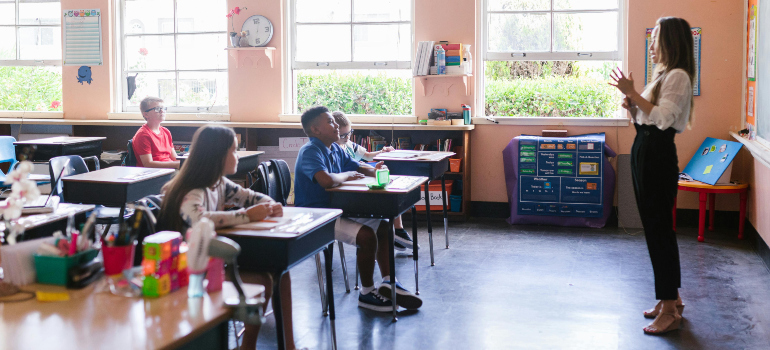International Moving with Children: Schools and Education
Get a QuoteInternational moving with children presents many challenges, particularly regarding their education. Ensuring a smooth educational transition is crucial for their well-being and academic success. This guide by Interstate International will assist you in navigating the complexities of schools and education during an international move. We will cover essential topics such as researching education systems, choosing the right school, handling enrollment, and providing emotional support. By following these steps, you can effectively meet your child’s educational needs throughout the move.
Researching Education Systems
Before you book international relocation services, dive deep into understanding the local education system of your destination. Education varies significantly across the globe, each country adopting unique philosophies and methodologies. Some nations prioritize standardized testing, while others champion creative thinking and holistic development.
Consider the starting age for schooling: in some countries, children begin their educational journey at age five, while in others, it’s common to start at six or seven. Assessment methods also differ widely; some systems are exam-centric, whereas others rely on continuous assessment to gauge student progress.
The school year structure also changes. Some countries have long summer breaks, others have shorter, more frequent vacations. Knowing these details helps ensure a smoother transition for your family.

Public vs. Private Schooling Options
When choosing between public and private schools, several factors come into play. Public schools are typically free and funded by the government, providing a good education but often with larger class sizes. In contrast, private schools usually charge tuition but offer more resources and extracurricular activities. They often boast smaller class sizes and provide more personalized attention. However, the cost can be high, so it’s important to consider your budget and manage finances carefully when making this decision.
International Schools
International schools provide a familiar curriculum for expatriate families, often following the International Baccalaureate, British, or American systems. These schools emphasize critical thinking, global awareness, and a broad education with a variety of elective subjects. Offering a consistent education regardless of location, they help ensure continuity in your child’s learning experience.
The diverse student body in international schools aids in cultural adjustment, fostering a global perspective. With English typically being the primary language of instruction, they are an excellent fit for English-speaking families. Additionally, these schools offer robust support for students’ social and emotional needs, which is especially important during a significant relocation.
Choosing the Right School
Each child has unique needs. Therefore, consider what environment will help them thrive. Think about their academic strengths, interests, and social needs. Also, consider any special educational requirements they might have.
Visit potential schools if possible. Then, look at the facilities, talk to teachers, and observe the classrooms. Ask about class sizes, teaching methods, and extracurricular activities. Check the school’s approach to discipline and support services. This will give you a better understanding of the school’s environment.
Moreover, speak with other expat families. Read online reviews and ask for recommendations from colleagues. Personal experiences can provide valuable insights. Join online forums or local expat groups to gather more opinions.
Handling the Enrollment Process
Gather all necessary documents early to avoid delays. Typically, you will need:
- Birth certificates
- Previous school records
- Immunization records
Check if any documents need to be translated or notarized. Having everything ready in advance can speed up the enrollment process.
Each school has its own application process and deadlines. Some schools have long waiting lists, so apply as early as possible. Research each school’s requirements and make a checklist. Contact the schools directly if you have any questions about the application process. Staying organized will help you secure a spot for your child.
Addressing Language Barriers
Many schools offer language support programs for non-native speakers. These programs help children learn the local language and adjust to their new environment. So, it’s wise to ask about these programs during school visits. Also, find out if there are additional costs or if they are included in the tuition. Knowing what support is available can ease your child’s transition.

Prepare your child for the language change by encouraging them to learn basic phrases before moving. Use language learning apps and practice speaking at home. This will help them feel more comfortable and confident. In addition, watching local TV shows or reading books in the new language can be beneficial. Creating a supportive and immersive environment at home will help your child adapt more easily.
Supporting Your Child’s Transition During International Moving with Children
Moving can be emotionally challenging for children, so it’s important to support them throughout the process. Talk to your child about their feelings and encourage them to express any concerns. Reassure them that it’s normal to feel anxious about the move. Spend quality time together to help them feel secure and encourage them to join clubs or activities at their new school. This will help them make friends and feel more at home in their new environment.
Managing Educational Continuity
Make sure the new school’s curriculum aligns with what your child has previously learned. This helps prevent gaps in their education. Therefore, discuss curriculum details with teachers at both the old and new schools. In addition, gather syllabi and textbooks from the previous school to share with the new teachers. This information can help them understand your child’s academic background.

Keep detailed records of your child’s academic achievements. This includes report cards, standardized test scores, and examples of their work. These records can help with placement in the new school. Also, having a comprehensive record can ease the transition and ensure your child is placed in the appropriate grade and courses. In addition, keep copies of any special education plans or accommodations. This way your child can continue to receive necessary support.
Successfully Managing International Moving with Children
International moving with children requires careful planning, especially when it comes to their education. Essential steps include researching education systems, choosing the right school, handling enrollment, addressing language barriers, supporting your child’s transition, and managing educational continuity. By hiring the best logistics company in Virginia, you can focus on creating a supportive educational environment for your child while the movers handle the logistics. This approach ensures your child’s success, helping them adapt and thrive in their new school.
